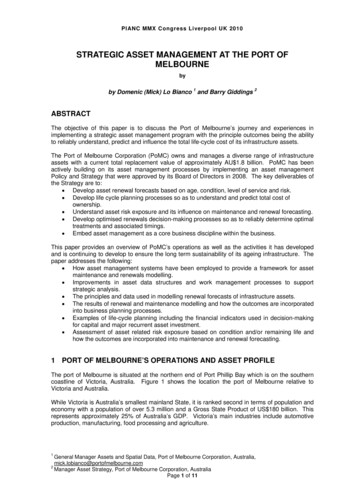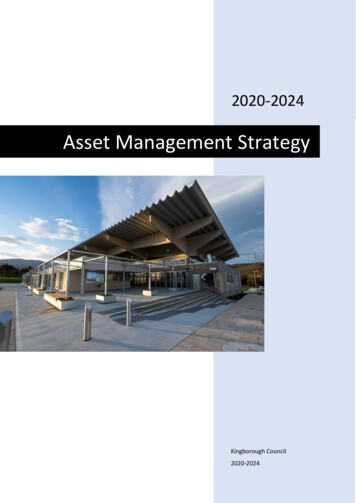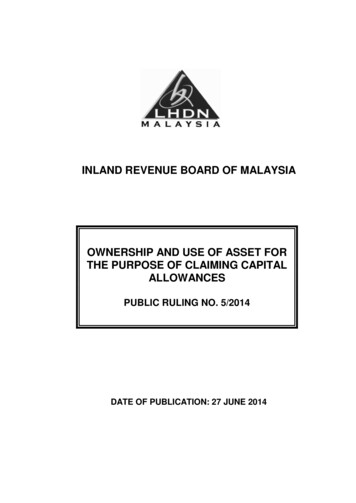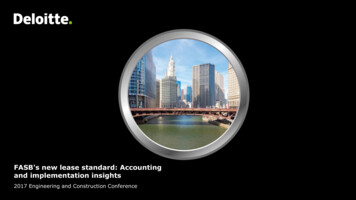
Transcription
PIANC MMX Congress Liverpool UK 2010STRATEGIC ASSET MANAGEMENT AT THE PORT OFMELBOURNEbyby Domenic (Mick) Lo Bianco 1 and Barry Giddings 2ABSTRACTThe objective of this paper is to discuss the Port of Melbourne’s journey and experiences inimplementing a strategic asset management program with the principle outcomes being the abilityto reliably understand, predict and influence the total life-cycle cost of its infrastructure assets.The Port of Melbourne Corporation (PoMC) owns and manages a diverse range of infrastructureassets with a current total replacement value of approximately AU 1.8 billion. PoMC has beenactively building on its asset management processes by implementing an asset managementPolicy and Strategy that were approved by its Board of Directors in 2008. The key deliverables ofthe Strategy are to: Develop asset renewal forecasts based on age, condition, level of service and risk. Develop life cycle planning processes so as to understand and predict total cost ofownership. Understand asset risk exposure and its influence on maintenance and renewal forecasting. Develop optimised renewals decision-making processes so as to reliably determine optimaltreatments and associated timings. Embed asset management as a core business discipline within the business.This paper provides an overview of PoMC’s operations as well as the activities it has developedand is continuing to develop to ensure the long term sustainability of its ageing infrastructure. Thepaper addresses the following: How asset management systems have been employed to provide a framework for assetmaintenance and renewals modelling. Improvements in asset data structures and work management processes to supportstrategic analysis. The principles and data used in modelling renewal forecasts of infrastructure assets. The results of renewal and maintenance modelling and how the outcomes are incorporatedinto business planning processes. Examples of life-cycle planning including the financial indicators used in decision-makingfor capital and major recurrent asset investment. Assessment of asset related risk exposure based on condition and/or remaining life andhow the outcomes are incorporated into maintenance and renewal forecasting.1 PORT OF MELBOURNE’S OPERATIONS AND ASSET PROFILEThe port of Melbourne is situated at the northern end of Port Phillip Bay which is on the southerncoastline of Victoria, Australia. Figure 1 shows the location the port of Melbourne relative toVictoria and Australia.While Victoria is Australia’s smallest mainland State, it is ranked second in terms of population andeconomy with a population of over 5.3 million and a Gross State Product of US 180 billion. Thisrepresents approximately 25% of Australia’s GDP. Victoria’s main industries include automotiveproduction, manufacturing, food processing and agriculture.1General Manager Assets and Spatial Data, Port of Melbourne Corporation, r Asset Strategy, Port of Melbourne Corporation, AustraliaPage 1 of 11
PIANC MMX Congress Liverpool UK 2010Figure 1: Location of the port of Melbourne in Victoria, AustraliaThe Victorian State Government created PoMC through a legislative reform process in 2003 tostrategically manage the port of Melbourne on its behalf. PoMC is a Government BusinessEnterprise with one shareholder - the Victorian State Government.PoMC’s legislated functions include: Management and development of the port of Melbourne in an economically, socially andenvironmentally sustainable manner. Ensuring essential services are available and cost effective. Ensuring effective integration of the port with other infrastructure systems. Facilitation of trade growth. Management of shipping channels in the port for use on a fair and equitable basis.The port of Melbourne is Australia’s premier container port and handles about 2.3 million TEUannually which represents approximately 36% of the nation’s container trade. The port ofMelbourne is in the top 50 ports globally.Approximately 3,600 ships visit the port of Melbourne every year including about 50 cruise shipsthat berth at the heritage listed Station Pier. All of this activity represents an approximate value oftrade through the port of US 60 billion.In order to strategically manage the port of Melbourne, PoMC relies heavily on the developmentand operation of a diverse range of highly critical assets. As an infrastructure rich organisation, it isincumbent on PoMC to continually manage its infrastructure assets over their life cycle so as toensure an appropriate level of service is maintained to its customers and stakeholders at thelowest possible cost and within an acceptable risk regime.PoMC’s Corporate Plan requires the development of fit-for-purpose services and facilities whichare secure, reliable, technologically efficient, innovative, safe and meet customers’ needs. Toensure this is achieved, PoMC’s Corporate Plan incorporates the following business objectives: Application of prudent life cycle management. Development of long term plans for port development, access and support services. Facilitation of appropriate capacity of services, facilities and infrastructure within the port.Page 2 of 11
PIANC MMX Congress Liverpool UK 2010The inclusion of these objectives in PoMC’s Corporate Plan indicates that there is a clearrecognition and commitment at the highest level that PoMC will retain best practice assetmanagement capability and continually recognises the importance of its physical infrastructure insupporting service delivery.As a result of a commitment to undertake several major port infrastructure developments over thepast two and the next five years, and an increase in community expectations on PoMC operating amajor city port, PoMC has implemented several initiatives to proactively manage balance sheetpressure on the business.One of these initiatives is the implementation of a strategic asset management program that willensure that step improvements are made in the commercial rigor applied to PoMC’s infrastructurerenewal programs into the future. PoMC’s high level infrastructure portfolio is shown below inTable 1:Asset ClassQuantityReplacement Cost (AU m)Wharves/Jetties64 863.7Buildings136 142.1Road, rail and stacking areas73 135.9Utility services274 33.3Plant & equipment (inc. 3 survey vessels)194 26.7Navigation aids275 16.1Navigation equipment717 2.6Land improvements434 590.32,232 1,810.7TotalTable 1: High level asset portfolioMore specifically, PoMC’s infrastructure portfolio includes the following major components: 34 commercial container, liquid bulk, break bulk and motor vehicle berths 7 kilometre’s of wharf length 35 major tenants 125 buildings 13.7 kilometres of roads 9.5 kilometres of rail Over 510 hectares of land Over 21 kilometres of waterfront and 100,000 Hectares of port waters in Port Phillip BayPoMC invests substantially in the maintenance of its dredged waterways through an annualisedAU 4-5million dredging program and also invests approximately AU 20-40 million in the renewaland rehabilitation of its infrastructure assets.2 STRATEGIC ASSET MANAGEMENT POLICY FRAMEWORK2.1GeneralIn early 2008 the PoMC Board adopted a policy position in relation to strategic asset managementwithin the business and consequently adopted a new Asset Management Strategy (Strategy).2.2Asset Management PolicyThe Board adopted Asset Management Policy (Policy) places several obligations on PoMC toimplement best practice asset management protocols within the business. While several of theseobligations are legislated requirements, the Board also recognises that PoMC must manage itsPage 3 of 11
PIANC MMX Congress Liverpool UK 2010infrastructure in a sustainable manner and achieve a commercially sustainable return on itsinvestment so that it can deliver its obligations to stakeholders and customers into the future.The Policy articulates the following activities as fundamentals to maintaining basic assetmanagement: Maintain a computerised asset management system that incorporates a comprehensiveregister of all of PoMC’s infrastructure assets. Maintain appropriate interfaces between the asset management system and all otherrelevant corporate systems that support asset management, eg. property, financial,document management systems and the Geographical Information System (GIS). Maintain a robust asset condition rating methodology framework and apply this to allrelevant PoMC assets. Maintain a structured asset inspection regime to facilitate the timely reporting of defectsand the development of maintenance plans. Maintain a costing and valuation history for assets and develop an appropriate unit coststructure. Ensure infrastructure assets are maintained in a fit-for-purpose state. Establish and manage scheduled and unplanned maintenance and associated budgets sothat assets are maintained in a condition suitable for their intended use. Establish appropriate performance or prescriptive based inspection and maintenancecontracts with suitably qualified providers. Ensure all relevant assets comply with appropriate Acts, Regulations, Standards andGuidelines. Develop and maintain standard operational policies and procedures for PoMC assetswhere relevant. Maintain appropriate backup systems for mission-critical assetsThe Policy also articulates the following strategic asset management objectives: Where possible, employ demand-management principles to minimise the need to createnew or renew existing assets. Understand PoMC’s risk exposure from its entire infrastructure asset portfolio, particularlyfrom underperforming assets. Define responsibility, accountability and reporting requirements in relation to theperformance of assets. Use whole-of-life costing and discounted cash flow techniques when considering new orreplacement asset options. Use optimised decision-making techniques when considering asset renewal options toensure that renewal strategies are based on return-on-investment and whole-of-life cyclecapital, operations and maintenance costs. Develop and maintain long-term asset renewal strategies based on risk exposure,condition/level of service requirements and commercial utilisation arrangements.2.3Asset Management StrategyThe Strategy adopted by the Board in early 2008 articulated the ‘road map’ for PoMC to progressfrom its previously successful, albeit basic, approach to asset management to a more strategic andpro-active methodology under a structured improvement program.PoMC’s asset management improvement program is based on the achievement of the followingkey principles aimed at consolidating PoMC as a cohesive and high performing world class assetmanagement organisation: Build a unified organisational focus with consistent policies, procedures, and clarity overresponsibilities for asset performance. Embed asset management as a core business discipline within corporate processes. Remove silo-based asset management processes and improve corporate consistency. Move from project-centric to whole-of-life philosophy. Improve clarity over measurement of asset performance. Standardise approach to life cycle planning and costing methodologies.Page 4 of 11
PIANC MMX Congress Liverpool UK 2010 Develop Asset Management Plans for key infrastructure assets that align and supportservice outcomes and corporate goals.Make sustainable decisions based on whole-of-life cycle costs, risk, level of serviceconsiderations and return on investment.Develop and implement a suite of technology systems and tools to support the strategicasset management decision-making processes.Implement an appropriate best practice asset management training program for PoMCstaff likely to influence asset management decision-making.Build competency and intelligence in strategic asset management across PoMC.Develop tools to assist with long term renewals planning and optimised renewals decisionmaking.3 IMPLEMENTATION PROGRAM3.1Previous Basic ApproachPoMC’s previous approach to asset management was based on a structured asset conditioninspection program for major assets using specialist engineering consultancies to develop capitalworks and maintenance programs. To facilitate the realisation of the inspection program PoMCretained the services of a panel of consultancies with expertise in a range of disciplines relevant tomarine engineering operations.The inspection reports procured for all commercial wharves, large cargo sheds and roads wereused to scope and determine cost estimates for capital rehabilitation and ongoing maintenanceworks. Capital rehabilitation projects identified through the asset condition inspection programwere considered for inclusion in the five year capital works program.While the reports include an analysis of repair, rehabilitation and renewal options for particularassets and associated net present value cost estimates for each option, the intellectual property ofthese decisions was retained by the consultants and as such PoMC’s technical engineering staffwere somewhat divorced from the accountability obligations of being the ‘asset owner’.All maintenance works were carried out by appropriately qualified and competent contractors undereither fixed term or project specific contractual arrangements. To support these activities, acomputerised asset management system was purchased and standardised works managementprocesses adopted.3.2Strategic Approach and ContextOne of the key drivers for progressing to a new strategic asset management regime was thatPoMC recognised that an increasing portfolio of ageing and expensive assets over time leads to anincrease in business risk exposure. The need to identify and strategically manage future assetrenewals by providing a robust methodology for directing funds to assets that deliver the greatestreturn on investment was considered paramount.It was further recognised that improved customer satisfaction levels and company profits are adirect result of sound asset management practices, and that the implementation of strategic assetmanagement facilitates the identification of potential cost saving opportunities and improved controlover maintenance budgets.The main area of attention to achieve the step improvement was the development of technicalinformation systems. However it was recognised that of equal importance was the implementationof appropriate business processes and the provision of appropriate skills training for people whowill ultimately be called upon to interpret system outputs and make judgement decisions based onbest practice standards, commercial imperatives and sound asset management experience.The focus of the delivery program was broader than a simple implementation of new businessprocess, new data management techniques and improvements in technical systems and software;it also commanded close management of the cultural shift required across the business.Page 5 of 11
PIANC MMX Congress Liverpool UK 2010Figure 2 below shows a maturity model pyramid developed internally within PoMC that articulateshow the step improvement process was measured and benchmarked. It can be see that PoMCprogressed substantially since 2006 during which time it was operating at a basic level of assetmanagement. It is anticipated that PoMC will progress to the strategic level by mid to late 2010.Figure 2: Asset Management Maturity Model3.3Strategic Asset Management PrinciplesOne of the fundamental differences between basic and strategic asset management is thatstrategic asset management is an output driven process whereas basic asset management ispredominately about inputs.The key benchmarks for measuring success in terms of having achieved strategic assetmanagement operations may be summarised be asking the following questions: Is long range renewal planning undertaken within a level of service context? Is historical data used for strategic renewals decision making and predictive modelling? Is possible to begin to predict likely asset failures and pro-actively manage accordingly? Is asset risk management integrated into decision making? Are renewals options decision making based on present value return on investment? Are infrastructure planning processes based on ‘whole of life’ costs?These benchmarks may be further distilled down to the following four main processes andelements of system functionality: Renewals Modelling. Risk Management Optimised Renewals Decision Making, and Life Cycle Planning.The status of the implementation of each of these processes and systems at PoMC is discussed ingreater detail below.Page 6 of 11
PIANC MMX Congress Liverpool UK 20103.4Renewals ModellingPoMC has worked co-operatively with a leading global engineering firm to implement a renewalsplanning module that interfaces with its primary asset management system to produceinfrastructure renewals profiles into the future.The renewals planning module takes asset data such as physical attributes, unit or override costs,condition data and failure data from the asset register and, based on particular managementstrategies and typical degradation curves configured in the renewals planning module, generatesrenewal profiles over a user defined time scale.Figure 3 shows an early 30 year asset renewal profile output from the system for PoMC’s fourmajor asset classes; wharves, rail, navigation systems and buildings. It is also possible to imposethe current level of renewals expenditure and new capital initiatives proposed on this image. Thislevel of analysis provides a first level view at the likely asset renewal obligations imposed on thebusiness going forward.Figure 3: 30 Year Infrastructure Renewal ProgramFurther analysis of this profile is possible by understanding the main assets that are ‘driving’ thespikes in the profile. Once determined additional analysis is able to be performed to determine thefeasibility of delayed the renewal of those particular assets until a later time, preferably during aperiod of time when planned expenditure is lower. The aim of this iterative process is to ‘flatten’the histogram and enhance renewals affordability on an on-going basis.The Optimised Renewal Decision Making tool, which is planned for release in a productionenvironment by mid 2010, provides the key functionality to conduct this second level analysis.3.4Risk ManagementIt is important to understand the risk profiles related to assets, particularly underperforming assets.Asset risk exposure is an important input into the renewals modelling process as it provides vitalsupport into the decision making process of deferring ‘scheduled’ renewals. As risk is an annualrepresentation of the cost of uncertainty, considerations to delay vital asset renewals cannot bemade without first understanding the consequences of such delays and evaluating these costsagainst other cost and revenue considerations.Page 7 of 11
PIANC MMX Congress Liverpool UK 2010Annual risk exposure is the product of the probability (or likelihood) of failure occurring (taking intoconsideration the application of potential redundancy systems) and the consequences of thatfailure.Risk / failure mode ( ) Probability (o.n) x Consequence ( ) x Redundancy factorIt was a relatively straight forward process to establish an asset risk management framework forPoMC as PoMC already has in place a structured business risk management framework that wasreplicated with appropriate modifications. It was found that PoMC’s asset risk profile is severalorders of magnitude lower that its Business risk profile.Figure four shows the relationship between asset risk exposures and the asset renewals profile.Figure 4: Asset Risk Profile Related to Asset RenewalsIt should be noted that the risk profile fluctuates despite the consequences of failure remainingstatic. This is because of the inverse relationship that exists between the asset renewal profile andprobability of failure, which is the other variable used to calculate risk exposure. Fundamentally,when an asset is renewed its condition is improved so its likelihood of failure is reducedaccordingly.3.6Optimised Renewals Decision-MakingDevelopment of this functionality is well advanced such that it is scheduled for release about mid2010. This functionality is essentially a financial modelling process whereby the costs and benefitsassociated with a particular treatment option are evaluated to give a net benefit, i.e. benefitsderived by applying the particular treatment less any associated costs.By considering a ‘deferral’ of a particular treatment by one year, a similar outcome is obtained,however the ‘accumulated’ benefits and costs over that year are also considered. Accumulatedbenefits and costs may be an accumulation of risk exposure, maintenance cost and opportunitycosts etc.The model will run the same analysis over several ‘deferral’ years to produce a series of plots thatindicate the present value of the net benefits and the time at which the optimisation occurs. Typicaltreatment options include; do nothing, rehabilitate, renew and replace. With all of these treatmentoptions, a ‘standard’ repeat cycle is assumed, for example, a rehabilitation may have to berepeated every, say 10 years whereas the replacement options provides a new design life.Page 8 of 11
PIANC MMX Congress Liverpool UK 2010This functionality may be used on either an individual asset or a generic asset to determine genericoptimal treatment options for similar assets in similar physical and financial circumstances. Thisfunctionality provides valuable intelligence input into the process of ‘flattening’ spikes in a renewalprofile as it considers every cost element that may have a bearing on whether an asset’s plannedrenewal may be delayed.Figure 5 shows the present value net benefit curves for three treatment options underconsideration for a particular asset. From the graph it can be seen that the optimal renewalstrategy for this asset is to do nothing until 2010 and then undertake a major renovation of thefacility.Figure 5: Optimised Renewals Decision Making Output3.7Life Cycle PlanningThe Life Cycle Planning module has been incorporated into PoMC’s core asset managementsystem and as such takes feeds directly from the asset database to populate whole of life costs ofbuilt assets.The main strength of this module is its foreword planning capability which assesses the discountedwhole of life costs of assets during the planning phase. By undertaking this analysis an informeddecision is able to be made in relation to selecting a particular development configuration that willdeliver the lowest life cycle cost while the asset proposal is still ‘of the drawing board’.Page 9 of 11
PIANC MMX Congress Liverpool UK 2010Figure 6: Life Cycle Planning – Case StudyFigure 6 shows the three main cost elements of a particular asset development scenario andindicates that a low capital cost proposal to install a series of navigation buoys in Port Phillip Bay todelineate a shipping Fairway is in fact a more expensive option than constructing navigation pileswith a higher capital cost. This can often be the case if a cheaper capital cost scenario has ahigher annual operations and maintenance costs.3.8Data structures and supporting technologiesTo support the above strategic asset management processes and systems, a substantial amountof effort has been invested into the development of robust interfaces to PoMC’s GIS to provide aspatial awareness around decision making.PoMC has also invested heavily in the development of mobile computing technology within itsasset management system to streamline operational activities such as condition assessments,asset inspections and remote access by contractors to close work orders directly in the assetmanagement system. In this way a full works and failure history is stored against the asset recordby the contractor, subject to PoMC validation. Works and failure history data is vital to therefinement of the management strategies incorporated in the renewals profile module and its use inadvanced decision making is a key benchmark for measuring success in strategic assetmanagement.3.9Business Processes ReviewsA significant component of the Strategy was the delivery of an asset management awarenessprogram for members of staff and senior managers who have an interest in asset management.The relaxed lecture style process used to deliver this program worked well as it raised theawareness and interest of all participants, including those with only a cursory involvement in assetmanagement.Substantial benefits to the organisation have already been realised through the refinement of itspre-existing long term asset investment program by the adoption of the 30 year renewals modellingoutputs. These outputs are now included in PoMC’s corporate financial modelling and in aninfrastructure planning sense.PoMC’s infrastructure development protocols have also been reviewed and amended toaccommodate whole of life cost outcomes for the evaluation of major infrastructure initiatives.Page 10 of 11
PIANC MMX Congress Liverpool UK 2010Maintenance and inspection procedures by operational staff and contractors have been reviewedand refined to make full use of the advantages provided by mobile computing and secure remoteaccess by contractors.CONCLUSIONAs a Government Business Enterprise 100% owned by the Victorian State Government, PoMC hastaken a policy position towards impmementing a strategic asset management framework for thelong term sustainable of its infrastructure assets.This approach has seen the implementation of a substantial amount of new technologies andamended business proceses across the business over the past three years. With the workcompleted to date, the achievement of PoMC’s objectives in relation to strategic assetmanagement, are well advanced.While an enormous amount of work has been completed by a dedicated team of committedprofessionals to move PoMC from a basic to an advanced level of asset management, there stillremains a substantial amount of work to be done to progress PoMC to a best practice organisation,however a program is in place to achieve that goal in 2010.ACKNOWLEDGEMENTSThe strategic work described in this paper was fundamentally developed in house by Port ofMelbourne Corporation staff with assistance from external engineering consultancies GHD Pty Ltdand Odysseus-imc Pty Ltd.REFERENCES International Infrastructure Manangement Manual, International Edition 2006Optimised Decision Making Guidelines, Edition 1.0, November 2004Page 11 of 11
PIANC MMX Congress Liverpool UK 2010 1 General Manager Assets and Spatial Data, Port of Melbourne Corporation, Australia, mick.lobianco@portofmelbourne.com 2 Manager Asset Strategy, Port of Melbourne Corporation, Australia Page 1 of 11 STRATEGIC ASSET MANAGEMENT AT THE PORT OF MELBOURNE by by Domenic (Mick) Lo Bianco 1 and Barry Giddings 2 ABSTRACT











